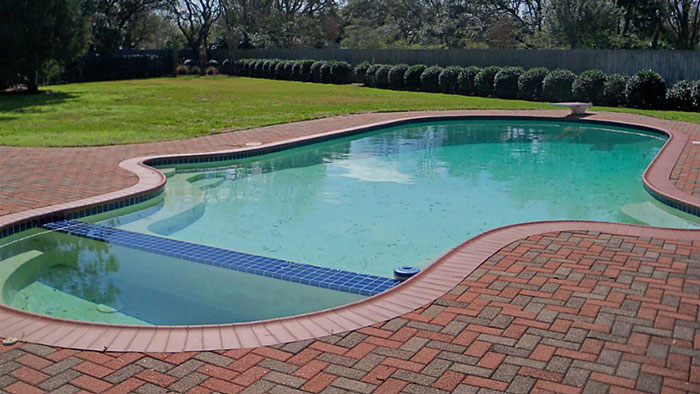No pool will look attractive unless the surrounding area is treated in some way. Most pools are surrounded by tiles, natural stone or concrete that are treated in some way to make them look more attractive. Unless there is some kind of hard surface, the surrounding area will end up getting muddy and this will be trodden into the pool itself, ruining the PH of the water. Even a grassed area can become muddy when it is constantly saturated with pool water.
There are usually pros and cons to each kind of treatment and sometimes which one is suitable depends on the location of the pool and to some extent on your lifestyle. A pool that has only occasional use by adults with less splashing of the surrounding area could have a different treatment than one that gets lots of use. Here are 3 different pool paving treatments to consider.
- Natural stone – can look really stunning and create an area around your pool that is cool underfoot and safe as far as slipping goes. There are several kinds of stone that can be used for pool surrounds.
- Sandstone
- Marble
- Granite
- Limestone
- Slate
Before choosing, you need to know that even with the use of sealer, some of the stone can become stained, especially if only the top is sealed, and ensure that you adhere to pool and spa construction guidelines. The stain can come from spilled products such as wine, but mostly it is caused by mineral salts that leach up from wet ground underneath. If the stone is sealed on the top and not the bottom the moisture cannot get out and salt deposits occur. This can be prevented by using stone that is less porous, or by sealing top, bottom and sides – and ensuring maintenance is regular and ongoing.
- Concrete – This is one of the most durable materials and is also slip resistant when wet. It is usually treated with a coloured sealer on the top to give an even safer surface and for aesthetic purposes. Such additions can also create texture, depending on what kind of roller is used for application. The variety of colour – from whites and browns through to black, greens and blue – enables you to make your pool surroundings unique and attractive. Concreting can also be combined with brickwork to provide an attractive pool surround that will last for years.
- Timber – We all know that timber is one of the most beautiful materials to use in any number of projects, but timber will rot when it gets wet, so can it really be used as a pool surround? The answer is a resounding yes! Some timber is naturally impervious to water – seen by those old timber pylons that hold piers up out of the water. It not only offers a non-slip surface but creates an ambience that is difficult to achieve with other materials. The secret to using timber is in the kind of timber that is used and the treatment it is given.
Timber has the advantage of being installed above the ground surface, thus allowing water from above or below to drain away freely. It should be oiled on a regular basis to protect it from sun and rain. Only use hardwood such as spotted gum for outdoor decking and pool surrounds.
No matter what material you use for swimming pool paving, it is important to follow the manufacturer’s recommendations for care afterwards.
